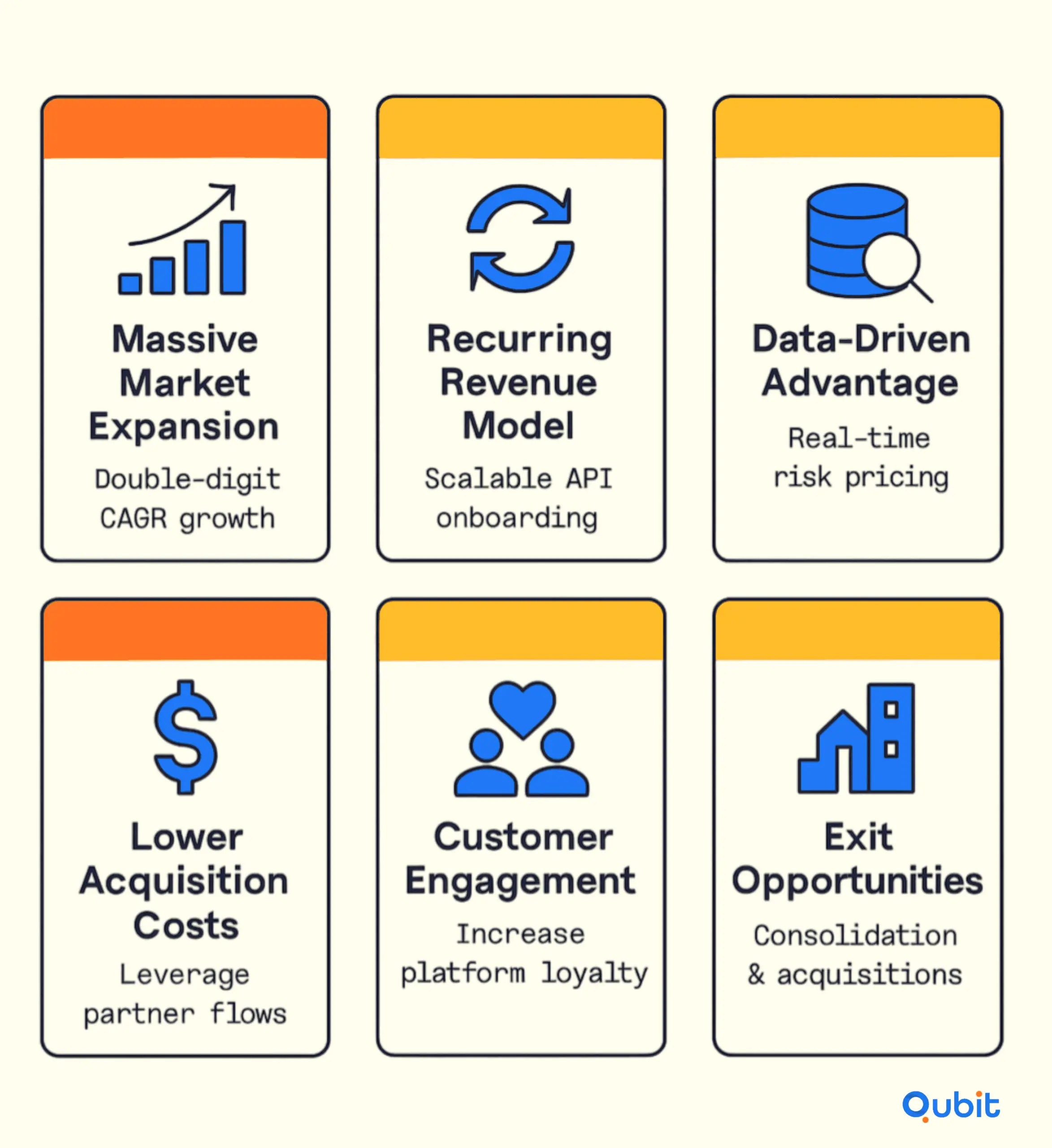Embedded insurance platforms are reshaping the financial landscape, offering seamless integration of insurance products into non-insurance ecosystems. This innovative approach is capturing the attention of investors, who see significant growth potential in its ability to enhance customer experience and drive revenue. By embedding insurance directly into consumer journeys, businesses can eliminate friction and boost adoption rates.
These platforms also highlight the importance of funding strategies tailored to their unique needs. For example, reference insurance startup fundraising strategies to situate their growth narrative within a broader framework of funding approaches.
This article explores the evolution of embedded insurance platforms, their funding dynamics, and why investors are betting big on this transformative model. Let’s jump right in!
What Is Embedded Insurance?
Embedded insurance refers to the integration of insurance products into the purchase journey of non-insurance goods and services. Instead of buying insurance separately, consumers can opt in (or are automatically covered) at the point of sale—whether they’re booking a flight, buying a car, or subscribing to a digital service.
Key Models:
- Billboard Insurance: Insurance is promoted alongside the main product but requires a separate transaction
- Intrinsic Insurance: Coverage is automatically included with a product (e.g., travel insurance with a flight ticket).
- Opt-in Bundled Insurance: Customers are offered insurance during checkout and can choose to add it.
- Opt-out Bundled Insurance: Insurance is pre-selected but can be declined by the customer.
The Market Opportunity: Explosive Growth and Investor Interest
The embedded insurance market is experiencing unprecedented growth:
| Year | Market Size (USD) | CAGR |
|---|---|---|
| 2024 | $97.57 billion | |
| 2025 | $116.49 billion | 19.4% |
| 2029 | $233.83 billion | 19% |
| 2030 | $950.59 billion | 35.14% |
Growth Drivers:
- Digital platform adoption: E-commerce and digital ecosystems are integrating insurance via APIs, making it more accessible and convenient for consumers.
- Customer experience: Embedded insurance removes friction, offering protection at the point of need.
- Market penetration: Reaches previously untapped or underserved customer segments.
- Operational efficiency: Streamlines distribution and reduces acquisition costs.
- Data and personalization: Real-time data enables tailored products and dynamic pricing.
Investor Perspective:
With such rapid expansion, investors are targeting startups that can scale embedded insurance solutions, especially those leveraging technology to disrupt traditional insurance models.
Why Embedded Insurance? The Value Proposition
For Consumers
- Convenience: Insurance is available exactly when and where it’s needed.
- Relevance: Products are tailored to specific purchases or activities.
- Affordability: Lower distribution costs often translate to more competitive premiums.
For Businesses (Ecosystem Partners)
- Increased revenue: New income streams through commissions or profit-sharing.
- Enhanced loyalty: Value-added services boost customer retention.
- Differentiation: Embedded insurance can set a platform apart from competitors.
For Insurers and Startups
- Lower acquisition costs: Leveraging existing customer flows of partners.
- Access to new data: Real-time behavioral data for better underwriting and pricing.
- Scalability: APIs and digital integration enable rapid expansion across partners and geographies.
Key Sectors and Use Cases
Embedded insurance is thriving across multiple sectors:
Technology: The Engine Behind Embedded Insurance
- Technological innovation is at the heart of embedded insurance’s rise:
- IoT (Internet of Things): Enables usage-based and telematics-driven insurance (e.g., pay-per-mile auto insurance)
- APIs: Allow seamless integration of insurance products into third-party platforms, enabling real-time quoting, underwriting, and policy issuance.
- Artificial Intelligence: Powers personalized risk assessment, dynamic pricing, and automated claims. For a better understanding you can also consider, how AI-Driven Underwriting & Predictive Analytics Are Winning Capital
- Data Analytics: Leverages transaction and behavioral data for more accurate underwriting.
- Blockchain: Enhances transparency and trust, particularly in claims and microinsurance.
The Competitive Landscape: Startups and Strategic Partnerships
Key Players:
- Startups: Cover Genius, Lemonade, Bolttech, and others are leading innovation, leveraging technology to streamline processes and enhance customer experience.
- Traditional Insurers: Partnering with tech startups or building their own embedded solutions to remain competitive.
- Platform Partners: E-commerce giants, fintechs, and super-apps are integrating insurance to enhance their offerings.
Challenges and Risks
While the outlook is overwhelmingly positive, embedded insurance startups face several challenges:
- Regulatory complexity: Navigating insurance regulations across multiple jurisdictions is complex and resource-intensive.
- Data privacy and security: Handling sensitive customer data requires robust cybersecurity and compliance with privacy laws.
- Partner dependency: Relying heavily on a few large platforms can create concentration risk.
- Customer education: Some consumers may not understand or value embedded insurance, especially if it’s opt-out or bundled by default.
The Embedded Insurance Investment Thesis

A. Massive Market Expansion
- The embedded insurance market is forecast to grow at double-digit CAGRs, reaching nearly $1 trillion in gross written premiums by 2030.
- Penetration is still in its early stages, especially outside electronics and travel, leaving significant room for growth.
B. Recurring Revenue and Scalability
- Embedded insurance models generate recurring revenue streams, with potential for rapid scaling across multiple partners and geographies.
- API-driven platforms can onboard new partners quickly, multiplying distribution channels without proportional increases in cost.
C. Data-Driven Differentiation
- Access to real-time behavioral and transactional data enables superior risk assessment, pricing, and product innovation.
- Startups that leverage data effectively can outpace traditional insurers in both customer acquisition and retention.
D. Lower Acquisition Costs
- By piggybacking on existing customer flows of digital partners, startups reduce marketing and distribution costs, improving margins.
E. Customer Engagement and Retention
- Embedded insurance enhances the value proposition of partner platforms, increasing customer stickiness and lifetime value.
F. Exit Opportunities
- As the market matures, consolidation is expected, with larger insurers and tech companies acquiring successful embedded insurance startups for their technology, partnerships, and customer bases.
What Investors Look for in Embedded Insurance Startups
| Investor Priority | What It Means for Startups |
|---|---|
| Scalable Tech Stack | Robust, API-first architecture for rapid partner onboarding |
| Distribution Partnerships | Relationships with major e-commerce, fintech, or super-apps |
| Regulatory Compliance | Ability to navigate multi-jurisdictional insurance laws |
| Data & Analytics | Advanced capabilities in real-time risk assessment |
| Product Innovation | Ability to quickly launch and iterate new insurance products |
| Customer Experience | Seamless, transparent, and value-adding integration |
| Team & Execution | Experienced leadership and operational excel |
The Future: Where Embedded Insurance Is Headed
Key Trends to Watch:
- Sustainability: Growing focus on green insurance products and ESG integration.
- IoT and Telematics: Usage-based insurance models will expand, especially in auto and health sectors.
- Blockchain: Adoption for claims automation, fraud prevention, and microinsurance.
- Personalization: Hyper-personalized products based on real-time behavioral data.
- Super-app Integration: Asia-Pacific’s super-apps will continue to drive innovation and adoption.
Conclusion
Embedded insurance platforms are reshaping the insurance industry, unlocking new value for consumers, businesses, and insurers alike. For startups, the opportunity is vast, but so is the competition. Investors are drawn to this space by the promise of explosive growth, recurring revenue, and the chance to disrupt a centuries-old industry.
Startups that combine technological excellence, strategic partnerships, regulatory savvy, and customer-centric innovation will not only attract investment but also define the future of insurance. As embedded insurance moves from novelty to necessity, the winners will be those who make protection as seamless, relevant, and accessible as the digital experiences it now inhabits.
If you're ready to explore the growth opportunities in embedded insurance, we at Qubit Capital can connect you with the right investors through our Investor Outreach service. Let us help you take the next step toward success in this evolving market.
Frequently asked Questions
What is embedded insurance?
Embedded insurance refers to the integration of insurance products directly into the purchase process of a primary product or service. This approach ensures immediate coverage, simplifying the customer experience by bundling insurance with the main offering.


 Back
Back



